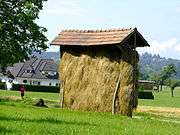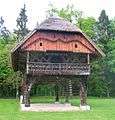Hayrack
A hayrack (Slovene: kozolec) is a freestanding vertical drying rack found chiefly in Slovenia. Hayracks are permanent structures, primarily made of wood, upon which fodder for animals is dried, although their use is not limited to drying hay.[1] Other food stuffs such as field maize are dried on them as well. Although it is a practical structure, a hayrack is often artistically designed and handcrafted and is regarded by Slovenes as a distinctive form of vernacular architecture that marks Slovene identity.[1]
.jpg)
Distribution
The hayrack can be found throughout Slovenia except in the Prekmurje region, eastern Styria and the Slovenian Littoral. Similar structures can also be found in Friuli in Italy[2] and in the East Tyrol region of Austria. In German, it is called Harpfe or Köse.[3]
Names and typology
Slovenian names for the hayrack include kozolec and kazuc (colloquial, usually referring to a single straight-line hayrack), stog (commonly found in Upper Carniola and especially in the area around Studor in the Bohinj region), and toplar.[1] Both kozolec and kozuc are probably diminutive forms of kozel 'goat', referring to a branching structure used for holding and drying hay or grain (cf. the similarly motivated German Sägebock and U.S. English sawbuck).[4] The word stog also refers to a haystack and is derived from Common Slavic stogъ 'stack, heap'.[4] The word toplar (or doplar) is borrowed from Austrian German Doppler, referring to a double structure in general.[4]
Specific varieties of hayrack include:
- Single straight-line hayrack (enojni stegnjeni kozolec)[5]
- Single straight-line hayrack with catslide roof (stegnjeni kozolec s plaščem)[5]
- Double straight-line hayrack (dvojni stegnjeni kozolec)[5]
- Roofed double hayrack (dvojni vezani kozolec)[5]
- Roofed double hayrack with one strut (dvojni vezani kozolec v eno drevo)[5]
- Roofed double hayrack with two struts (dvojni vezani kozolec v dve drevesi, toplar)[5]
- Roofed double hayrack with extension (toplar z repom)[6]
- Roofed double hayrack with shed (kozolec s hišo)[6]
- Split-level double hayrack (kozolec na kozla, kozolec na psa)[5]
 Single straight-line hayrack
Single straight-line hayrack- Single straight-line hayrack with catslide roof
 Double straight-line hayrack
Double straight-line hayrack- Roofed double hayracks
 Roofed double hayrack with two struts
Roofed double hayrack with two struts- Roofed double hayrack with extension
 Roofed double hayrack with shed
Roofed double hayrack with shed- Split-level double hayrack
Open-air museum
From 2010 until 2013, the Municipality of Šentrupert in southeastern Slovenia built the first ever open-air museum "Land of Hayracks" (slovene: Dežela kozolcev) in the southern part of Šentrupert, its administrative centre. The collection includes 19 hay drying devices, which includes 17 hayracks, with the oldest from 1795, and presents all types of hayracks. The museum also serves as a venue for events.[7] The main organiser of the project was Rupert Gole, the mayor of Šentrupert. Over 650 hayracks have been counted in the Mirna Valley, where the settlement lies. The largest of them and in the entire country is the Simončič Hayrack.[8]
Gallery
 A Valvasor copperplate engraving depicts filling a hayrack with hay
A Valvasor copperplate engraving depicts filling a hayrack with hay An abandoned single straight-line hayrack just outside Olševek in winter
An abandoned single straight-line hayrack just outside Olševek in winter
References
- Applegate, Toby Martin (2008). "he Kozolec: Material Culture, Identity, and Social Practice in Slovenia". Master's Thesis, University of Tennessee. Trace.tennessee.edu.
- Renzo Rucli, KOZOLEC monumento dell'architettura rurale. Cooperativa Lipa editrice, 1998
- Neusser-Hromatka, Maria. "Colourful Austria." Innsbruck: Pinguin-Verlag, 1977.
- Snoj, Marko. 2003. Slovenski etimološki slovar. Ljubljana: Modrijan.
- Oblak, Matija (2009). "Kozolec. Ljubljana: Fakulteta za gradbeništvo in geodezijo" (PDF) (in Slovenian).
- "Kozolec | Slovenski etnografski muzej" (in Slovenian). Etno-muzej.si. Archived from the original on 2014-03-12. Retrieved 2014-03-12.
- "Na Dolenjskem raste prvi muzej kozolcev na svetu" [In the Lower Carniola Grows The First Ever Museum of Hayracks]. MMC RTV Slovenija (in Slovenian). RTV Slovenija. 2 July 2012.
- Rajšek, Bojan (24 June 2012). "Kozolci ne bodo več propadali" [Kozolci Will Not Decay Anymore]. Delo.si (in Slovenian).
Further reading
- Čop, Jaka; Cevc, Tone: Slovenski kozolec = Slovene Hay-rack, Žirovnica 1993, Agens COBISS 35981824 (Slovene, English)
External links
| Wikimedia Commons has media related to hayrack. |
- kozolec.si - Various types of hayracks.